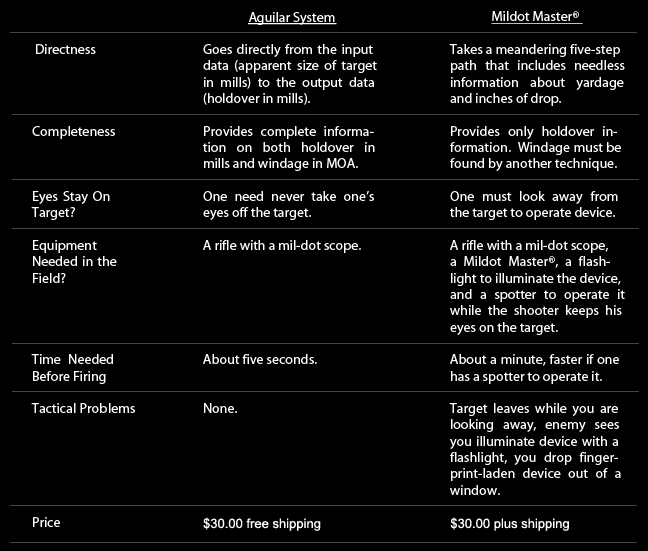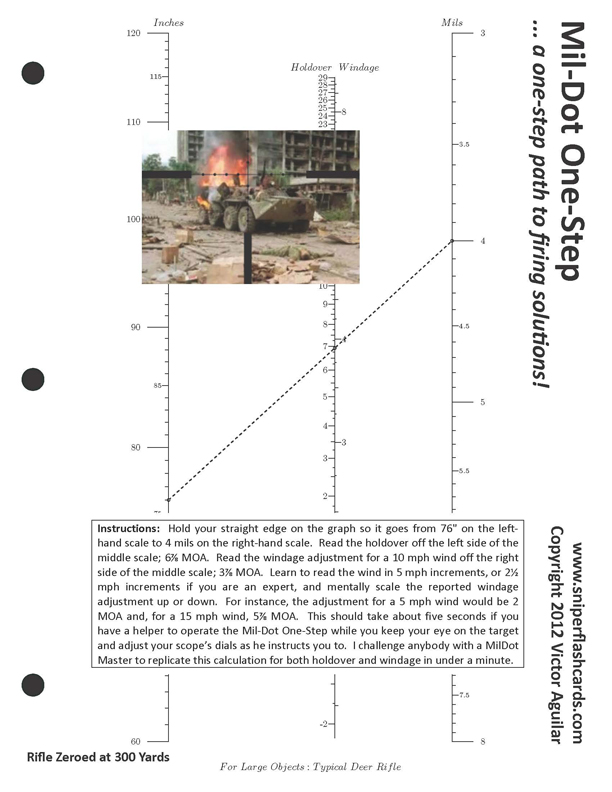|
Review of the Mildot Master®
Take a slide rule to a gunfight??? Let's see if that's really a good idea!
“Mildot Master® ...a direct path to firing solutions.®” is a registered trademark of Mildot Enterprises. But is it true? Is the Mildot Master® really a direct path to firing solutions? By my definition, a direct path is one that goes directly from the input data, apparent size of the target in mills, to the output data, holdover in mils and windage in MOA. Nothing on a rifle scope measures, or is calibrated in, yards or inches. So any time spent in combat figuring out yardage or bullet drop in inches is a needless detour. A quick glance at the Mildot Master® reveals that it is actually two slide rules, which must be operated one after the other for a total of four steps. The third step is flipping the device over to read one’s ballistic data and the fourth step is flipping it back over to input what one has memorized from the back of the device onto the second slide rule. So, to get from the input data, apparent size of the target in mills, to the output data, holdover in mills, one must meander through this four step process, learning all kinds of useless information about yardage and bullet drop along the way. In their instructions, Mildot Enterprises says it is a three step process, but that is because their third step has the word “and” dividing two distinct steps. Also, they don’t mention the acrobatic skills one must possess to operate the device with one hand, since one’s left hand is supporting the rifle. If you are sitting in a tree or leaning out a window and you cannot reach your hip pocket from your shooting position, you will have to hold the Mildot Master® in your mouth while making your shot. If you drop your Mildot Master®, you’re screwed. There is actually a fifth step that Mildot Enterprises neglects to mention in their instructions, interpolating between the ballistic data for targets that are not on a hundred yard line. Conveniently, all of the examples given, both on their website (www.mildot.com) and in their instruction manual, just “happen” to be for targets at ranges evenly divisible by one hundred. The ballistic data used for examples in the instructions for the Mildot Master® are as follows:  The second thing one notices is that linear interpolation does not work. Suppose one has been given data in 100 yard increments and one has determined that the range is 150 yards. By interpolating between 2.1” and 0.0” one would estimate the 150 yard drop to be 1.0”, which is 56% of the actual value, 1.8”. That’s not very good. The Mildot Master® can be used for shots out to 2000 yards and the error in interpolating between the inches drop at 1900 yards and at 2000 yards could be significant. Now consider the following chart:  So we see that it is a mistake to us a linear technique to interpolate data in inches, which are really quite curved, when one should interpolate the data in MOA, which are quite straight. But, because Mildot Enterprises prints their chart in inches of drop, it is natural for the user to interpolate the chart, that is, to insert the unmentioned fifth step after step three, when he has found the bullet drop in inches, not after step four, when he has found the MOA holdover. If the Mildot Master® had not taken him on this needless detour through such useless information as yardage to the target and inches of drop, he would have interpolated the final result, MOA holdover. The Aguilar System for Medium Range Sniping goes directly from the input data, apparent size of the target in mills, to the output data, holdover in mills. No inaccuracies are introduced because there are only two steps: Measuring an object of known height and holding over on the target. For more accuracy, one can hold halfway between two mill-dots. Because the interpolation is done on the second and final step, it is much more accurate than interpolating the data in inches provided with one’s Mildot Master®. Also, nothing on the Mildot Master® tells one anything about windage! So the Mildot Master® is not only an indirect path to firing solutions, it is an incomplete path to firing solutions. Since there is barely enough room on the back of a Mildot Master® for holdover data in 100 yard increments, dialing in windage using the information provided by the Mildot Master® requires an additional two or three steps and a separate data sheet. By far the worst problem with the Mildot Master® is not that it is indirect (five steps to determine holdover) or incomplete (nothing about windage), but that it requires one to take one’s eyes off the target. Military snipers work in teams and, if they have a 20× spotting scope with a mil-dot reticule, the spotter can measure things and take all the time he needs to fiddle with his Mildot Master® while the shooter keeps the target in sight. But civilian snipers work alone and there are real dangers with putting one’s rifle down. You might get dirt in the muzzle. The enemy might see you wiggling around. If you are firing from darkness into light (as you should be), the enemy will definitely see you when you turn your flashlight on to illuminate your Mildot Master®. But the biggest problem of all is that you may not be able to find your target again. Watch the movie Enemy At The Gates and imagine Vassili Zaitsev having to put his rifle down and monkey with a Mildot Master® after spotting a German sniper creeping through the rubble. That wouldn’t work. Enemy soldiers are like leprechauns – if you take your eyes off them for even a moment, they disappear. While the Mildot Master® is sorely lacking in windage data, it allow one to estimate the effects of firing downwards at an angle, which may convince some people to buy it. When developing my system, I considered the problem of snipers firing downwards at their targets and dismissed it as unimportant for two reasons: 1) For a civilian sniper (my target audience), climbing up to the roof of a building is tactical suicide because helicopters will shoot him and, when pursued, he will never get down in time to reach his getaway vehicle. 2) Even from the top of a five story building, a 500-yard shot is only going to be off by a fraction of an inch. The panoramic view from the roof may seem impressive but, in reality, it is only a 3° angle. Note. However, police snipers can get on the roofs of buildings because they control the airspace overhead and, since they are not going to be pursued, they can fire almost straight down at targets on the street in front of them. A city block is about 176 yards (a tenth of a mile) and, from the roof of a ten-story building, this is a 15° angle. So, should police snipers buy a Mildot Master for this reason? No. 15° angles have about as much effect on one’s shot as solar flares. I have a Mil-Dot One-Step specifically designed for police snipers that includes instructions for firing at a 15° angle and, at 176 yards, the difference between this and firing over level ground is not even a quarter MOA. Anyway, getting on top of a skyscraper and shooting people in the square in front of the building is the sort of thing that the Yemeni or Syrian government does. My company supports military snipers, mostly U.S., Ukrainian and others that fear the Red Army, who estimate range by measuring armored vehicles like the BTR-80 and who stay near the ground so they can run from the vehicle’s return fire, or hide in basements below the vehicle’s -6° angle of depression.Note. I hesitate to even have a Mil-Dot One-Step for police snipers because shooting at such steep downward angles is so closely associated with the killing of unarmed dissidents in the public’s mind that conjuring up a “bank robber” or some similar villain to justify one's focus on shooting downwards is a bit far-fetched. Since the Shilka can elevate its four autocannons to 85°, such snipers are obviously not fighting a real army (one with vehicles) but just shooting demonstrators. The Mildot Master provides information on shooting downwards at angles as low as -60° and I am happy to let them have this market – thugs and murderers. Far more people have been shot in the foot by snipers who thought it was important to hold under when firing downwards than have been missed by snipers who knew nothing at all about angles. My advice is that it doesn’t matter unless one is on a building of at least twenty-seven stories and is firing on targets less than two blocks away. If one does find oneself in this ridiculous position, just estimate the horizontal distance by how many blocks away the target is. The standard city block is 176 yards. They were smaller in the past, so the old part of town may have 100 yard blocks. If one has a 12” length of fishing line with a lead sinker attached to one’s Mildot Master®, as is recommended in their instructions, my advice is to tie the fishing line to your wrist so you don’t drop the device out of a window. Ignore the angle graduations printed on the front of the Mildot Master®. At the beginning of this review I said “Nothing on a rifle scope measures, or is calibrated in, yards or inches.” That is not entirely true. The Mark 4 by Leupold is available with dials calibrated in yards. They have two dials available: One for the Federal GM308M cartridge and one for the M118 military cartridge.1 Of course, a Mark 4 costs $2000, fully ten times the cost of the scope I recommend, the Bushnell ET1040 Elite Tactical with an illuminated mil-dot reticule. But my new Mil-Dot One-Step can be had for any caliber of rifle, heavy machine gun or cannon, so it is actually much more versatile and far less expensive than a Mark 4 scope. 
|

The Mil-Dot One-Step competes directly against the Mildot Master, beating it soundly at both accuracy and speed as well as providing windage information, which the Mildot Master lacks.
